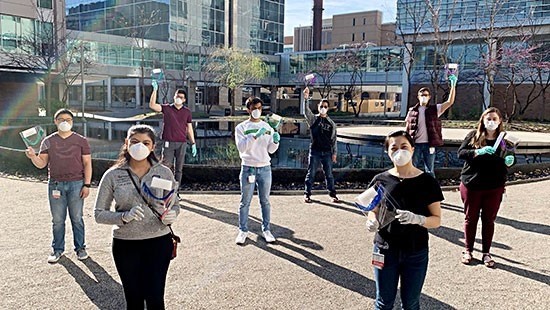The School of Medicine has established guidelines to manage the placement of visual displays, including artwork, portraits and graphics, in public and shared spaces on campus. When considering visual displays, the Departments and the School will work together to ensure the visual displays support and do not conflict with the University and School missions. The School of Medicine will pay special attention to campus diversity, equity and inclusion.
- Diversity: We are mindful of all dimensions of human differences and define diversity in the broadest sense to mean an inclusion of all persons regardless of racial and ethnic background, nationality, gender, gender identity, sexual orientation, veteran status, religious beliefs, ability, age, and socioeconomic status. Diversity embodies inclusiveness, mutual respect, and multiple perspectives and serves as a catalyst for change resulting in health equity.
- Inclusion: Isachieved by nurturing the climate and culture of the institution through professional development, education, policy, and practice. The objective is to create a climate that fosters belonging, shared respect, and value for all and encourages engagement and connection throughout the institution and community. Inclusion is a core element for successfully achieving diversity.
- Equity: We strive to ensure that all members of the WUSM community have access to opportunity and can attain their full potential by promoting fair treatment and proactively working to remove barriers that have prevented full participation by some populations. We recognize that equity is not achieved by treating everyone equally but rather by treating everyone equitably.
- Visual display: Depictions convey information using elements beyond, but not excluding, text. Examples include diagrams, maps, art, graphics, and portraits.
- Non-public (departmental space): Space with a primary occupant identified, including but not limited to private offices, break areas, corridors, waiting areas, and open workstations.
- Public space: A place generally open and accessible to the public.
- Shared space: Spaces that are designed to be shared and may reside within departments or at the school level, including but not limited to classrooms, meeting rooms, event spaces, lobbies, break areas, and general gathering and waiting areas.
- Shared public departmental space: Space that shares common areas, including lobbies and conference rooms, among multiple departments.
- Diversity, Equity, and Inclusion: Working to create a welcoming, diverse, and inclusive environment where everyone is valued and respected.
- University Mission: https://wustl.edu/about/mission-statement/
- School of Medicine Mission: https://medicine.wustl.edu/about/mission/
- School of Medicine Commitment to Diversity, Equity, and Inclusion: https://medicine.wustl.edu/about/mission/#diversity-statement
In support of this guideline, the School of Medicine will establish a Visual Diversity Advisory Committee that will serve as an advisory group to the Dean for public and shared spaces for existing and new buildings. The makeup of this advisory committee will represent the campus community. It will meet as needed to support campus planning, renovations, and new buildings (at minimum, annually).
Chair: Vice Chancellor, Medical Finance & Administration
Co-chair: Associate Vice Chancellor, Associate Dean, Diversity & Inclusion
Supporting Department: Operations & Facilities Management, Physical Planning (Interiors Team)
The Visual Diversity Advisory Committee will have representation from:
- Office of the Dean
- Office of Diversity, Equity & Inclusion
- Operations & Facilities Management Department
- Office of Medical Education
- Other WUSM representatives or constituents on an as-needed basis, dependent on the project.
- Campus Partner representatives are as-needed and dependent on the project, geography and shared space implications.
Visual Display Planning Principles:
Appropriate visual displays beautify the campus, encourage appreciation of art in various media and styles, offer enjoyment to the campus community and general public and memorialize important aspects of University tradition and campus culture. OFMD has created these planning principles to ensure visual displays complement and respect the campus character and are appropriate to its setting, history, traditions, culture and mission.
Representation Matters
Intersectionality and visuals help shape the perception of who is recruited, retained and contributes. Visuals are the first impression upon entering a space and can carry the value of a lasting impression. Imagery supports a culture but does not do the whole job. Visuals must communicate the school’s mission, history and values. A sensitive and consistent selection of diverse and inclusive imagery can help shape whether or not employees and the community feel welcome, connected and have a sense of belonging. These guidelines should authentically aim to create a pathway for connecting all constituencies.
- Selections should use visual displays that allow community members to embrace and connect with the school’s history, celebrate its current state and declare its future aspirations.
- Visual display representation should include proper branding.
- Visual displays should be congruent with supporting copy (such as legends, historical notes, labeling/ descriptions) to ensure messaging and visual displays are not in conflict.
- Visual displays should showcase inclusive teams with various community members. This allows for authentic connections across diverse community members, including position, culture, age, sexual orientation, gender identity or expression, race, and ability, among others.
- Visual displays should strive to support Diversity, Equity & Inclusion efforts.
Visual Diversity Selections
Imagery should reflect the School of Medicine as a dynamic institution, fostering excellence in all missions. Faculty, employees, residents, fellows, postdocs and students should be shown in context whenever possible to convey engagement with the world around them. The imagery of people in the campus setting should include physical highlights of the school, with community members interacting and engaging with each other in their environments.
Visual Diversity Examples




Campus Imagery
When campus imagery is shown, the imagery should feature the school’s architectural features, impact and scale of the Washington University School of Medicine campus. In addition, imagery should reinforce the institution’s mission, vision, values and community, speaking to the school’s endurance, stability and future.
Process for Visual Displays in Shared Public Departmental Spaces (Shared by Multiple Departments)
Departments should submit a proposal form for any visual displays that intend to be installed in shared public departmental space on campus.
- Submission of a proposal form for a shared public departmental visual display via the Visual Display Proposal Form on the OFMD website. Proposals from individuals or organizations outside of WUSM must be made in collaboration with a University partner.
- Describe the rationale and/or overall purpose of the visual display.
- Describe the significance of the artist, subject or honoree.
- Indicate any previous locations of the visual display (on-campus or off-campus), if applicable.
- If applicable, describe any awards, critical notice or notable significance of the visual display.
- Proposals identifying specific campus placement should include a justification for the site in question.
- Criteria for Selection
- The committee will review all visual display proposals using the following criteria:
- The message/ intention of the proposed display shall be acceptable to current missions, standards, policies and proper branding of the WUSM campus.
- The proposed display should have relative uniqueness, including factors of originality and authenticity.
- The proposed display should honor university ethics with an effort to integrate Diversity, Equity & Inclusion (DE&I) on campus.
- The proposed display should preserve or acknowledge history, heritage and culture.
- The display enhances the physical and aesthetic environment of the university.
- The proposed visual display should not impose unexpected or unsupportable burdens on the campus, such as the frequent need for maintenance and repair or unreasonable security costs.
- Proposals should include a funding source for the visual installation’s purchase, installation and maintenance.
- The committee will review all proposals. The advisory committee aims to operate on a timely and responsive basis relative to University units, donors and others.
- The Visual Diversity Advisory Committee will take the recommended proposals from the review to the Dean for approval.
- Upon the Dean’s approval, the committee will send the proposals to OFMD and DE&I for project initiation.
- The committee will review all visual display proposals using the following criteria:
Process for Visual Displays in Non-Public (Departmental) Spaces
- Those interested in installing visual displays in non-public spaces are encouraged to fill out the Visual Display Proposal Form for the advisory committee’s review. Committee approval is not required but the advisory committee urges all departments to follow the criteria above for visual displays in non-public spaces.